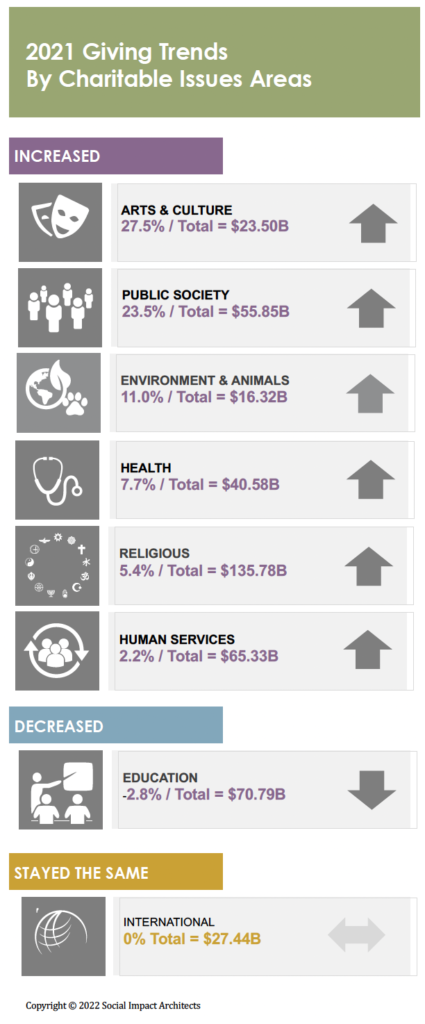 At the end of 2021, readers of The Boston Globe were asked to describe the year – the top word: “exhausting,” followed by “rollercoaster.” One reader noted that there were “some highs and lots of lows.” Each year since 1956, social sector leaders anxiously await the results of the Giving USA Report, which examines the past year and notes key data and trends, and I was among them. This year I was anxious to see how donors would respond to all these highs and lows. In 2021, Americans gave roughly $484.85 billion to U.S. charities, which was a 4% increase (with inflation factored in, it was a 0.7% decrease) from giving in 2020. After 2020, it was clear that nonprofits that embraced another word of the year – “pivot” – did better on average. To that end, we are sharing highlights from the annual update, some thoughts and ideas on today’s giving opportunities and challenges, and what the future may hold based on other donor-driven surveys and past economic downturns.
At the end of 2021, readers of The Boston Globe were asked to describe the year – the top word: “exhausting,” followed by “rollercoaster.” One reader noted that there were “some highs and lots of lows.” Each year since 1956, social sector leaders anxiously await the results of the Giving USA Report, which examines the past year and notes key data and trends, and I was among them. This year I was anxious to see how donors would respond to all these highs and lows. In 2021, Americans gave roughly $484.85 billion to U.S. charities, which was a 4% increase (with inflation factored in, it was a 0.7% decrease) from giving in 2020. After 2020, it was clear that nonprofits that embraced another word of the year – “pivot” – did better on average. To that end, we are sharing highlights from the annual update, some thoughts and ideas on today’s giving opportunities and challenges, and what the future may hold based on other donor-driven surveys and past economic downturns.
First, the good news: almost all issues areas did well – the chart below summarizes the changes in 2021. We saw that initial gains in public society, health and human services started to level out to pre-pandemic levels and gifts that were diverted away from arts, culture and humanities organizations rebounded as events and exhibits opened back up.
In 2021, we also saw a more modest increase in giving by foundations – with grantmaking mirroring past years’ growth with an increase of 3.4% (compared to 16% in 2020 when foundations pitched in with pandemic support) – totaling almost 19% of all giving in 2021. As corporations recovered, they gave more – rebounding 23.8% over 2020 (totaling 4% of overall giving in 2021).
Individual giving remained strong in 2021 (up 4.9%) due to the stock market’s growth for most of 2021. Individual giving still makes up the vast majority of giving in the U.S. – with almost 67% of total giving coming from individual gifts. Bequests had a significant decrease (down 7.3%) over the previous year (9% of the total), indicating the continued transfer of wealth from the baby boomer generation as well as the continued volatility of bequests from year to year.
Ideas for 2022
2022 has already started off with a bang and is likely to continue to be rocky with inflation and a possible recession. As a result, it is even more important for your development department to have a well-informed strategy. With inflation, we anticipate giving to flatline overall. During economic downturns, individuals don’t stop giving but become more thoughtful about their gifts – both in amount and direction. So, some charities – such as food banks and housing organizations – may see increased giving. And others may flatline or fare worse as belts tighten.
Here are some additional thoughts for consideration:
Idea #1: Leverage technology to tell your story to donors regularly
Whether through a database or social media, it is clear that nonprofits that were tech-forward fared best during the pandemic. We encourage you to practice hyper-stewardship to keep donors connected to your cause and tell them how they are making an impact. If you don’t have a working donor and messaging database, now is the time to get one. You’ll want one that helps you with analytics, customization, segmentation and automation of messaging. Make the most of your current database by regularly reviewing the data and pivot as needed based on the results of your collective work. The same is true of social media – all our surveys are saying that donors want more storytelling about the mission from nonprofits. Use emails and social media to tell these stories and ensure that your organization is top-of-mind as they make tough choices on their giving.
Idea #2: Rinse and repeat “cultivation-solicitation-stewardship”
The easiest donor to get is the one you already have. Disturbingly, only 20% of first-time donors are retained. And, with the pandemic, you likely gained new donors. It is important to work to keep them and boost their level of engagement from an episodic donor to a regular donor – now that they can engage directly with the organization. In 2021, we stressed the importance of the donor pyramid – begin to segment your audiences and find ways to go deeper with them. Think creatively and connect to your donors’ interests and talents. Consider ways you can engage them in the mission through tours, volunteer events or special campaigns focused on a client necessity (e.g., diaper drive, back-to-school). And with subscription services becoming the norm, consider a monthly donor campaign to move donors to a regular gift every month, so retention becomes even easier.
Idea #3: Elevate messaging through relevancy to current issues and alternate channels
Double-check your story. Is it resonating as it once did? Are you telling it in the right circles? We have always believed that nonprofits should stay within their mission, but they should also lead with messages around their unique value proposition and find ways to stand out from the crowd. However, what was considered unique and valuable pre-pandemic has changed in 2022, so your messaging has to shift with the times. We have written many blogs over the past year covering these topics, so we encourage you to really dig deep and rethink your value proposition and key messaging. Donors want to feel closely connected to your cause and want to see tangible examples of your mission at work. Remain relevant by showing – not telling – them that you are stepping up in 2022. And continue new ways of communicating, such as op-eds in the local newspaper, which lend credibility to your organization, and videos, which can keep your organization top-of-mind. Thirty-nine percent of people who watch a video look up the organization within a day of viewing it, so consider adding video content to your communications plan.
Idea #4: Implement (or un-pause) your planned giving strategy
We are currently experiencing the “Great Transfer of Wealth,” and over the next few decades financial experts are expecting that between $40 trillion and $140 trillion will be passed from one generation to the next. Up to one-third of this wealth will be transferred to nonprofits through planned giving. If you are not inviting your donors to leave a legacy in the form of planned giving to your nonprofit, you are missing out on potentially transformative funding for your mission. There are easy ways to implement a planned giving program for all levels of organizational capacity and budget sizes. Adding a statement about legacy giving on your marketing materials, requesting bequest donors self-identify and reviewing your donor data to identify planned giving prospects are just a few easy ways to implement a low-budget planned giving strategy.
Idea #5: Engage staff, board and volunteers in building a “culture of philanthropy”
Raising funds to support your mission is a team sport. As Ted Lasso says, “The harder you work, the luckier you get.” Use this economic shift in 2022 to rethink all your old fundraising ways and move toward a culture of philanthropy. This means that it is now in everyone’s job description to build relationships and assist with raising resources to support the organization. Use tools, such as Mission-Money Matrix, to chart return-on-impact as well as return-on-investment for all programs, services and events. Ensure that program staff have shared goals with fundraising and marketing staff to tell their story, measure their impact, and cultivate donors and prospects. Ensure that board members who don’t like to make “asks” contribute in other ways, such as calling existing donors with the latest news or to thank them for a recent gift. Adopt a culture of “we are all in this together” when it comes to fundraising and development. If you want a stellar guide on how to do this, we highly recommend the essential guide, Beyond Fundraising: What Does it Mean to Build A Culture of Philanthropy, funded by the Hass Jr. Fund.
Idea #6: Build trust & competence through transparency, governance and results
According to Edelman’s Trust Barometer, trust in nonprofits across the world has remained steady at 59-62% since 2018, comparable to trust in business at 61% and well above the 50-52% who trust government and media. The key differentiator across all groups is “information quality,” followed by collaboration, leadership and change management for nonprofits specifically. It is important to note that trust is eroding overall for the nonprofit sector in the U.S., and it is leading to more donors, especially those in Gen Z, to bypass traditional models and give directly to those in need (e.g., crowdsourcing). To mitigate this, the sector overall, but also nonprofits individually, must work that much harder to publish our results – programmatically, financially and socially (e.g., equity goals). These practices promote trust, both within the sector and of the sector. It is also an opportunity to showcase our collective force – how nonprofits are leading the charge to fight the impact of inflation on the most vulnerable, keep the economy moving and remind donors how much of the positive public work they experience is led by their local nonprofits.
2021 was a turbulent year of twists and turns. 2022 has come with both opportunities and challenges – this summer is a great time to review these trends against your experience and adjust your fundraising plan based on new information and insights. We welcome any additional analysis based on your proximity to donors as well as any ways your organization is shifting its fundraising efforts to better respond to their needs.

